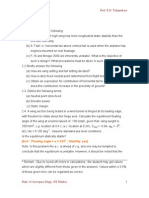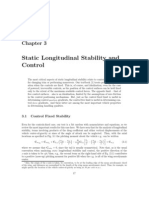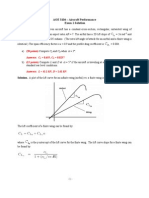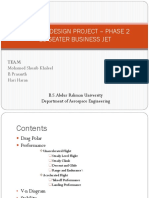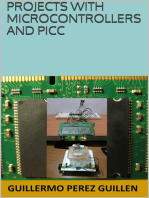Longitudinal Stick-Fixed Static Stability and Control Topics
Longitudinal Stick-Fixed Static Stability and Control Topics
Uploaded by
sameh hassanCopyright:
Available Formats
Longitudinal Stick-Fixed Static Stability and Control Topics
Longitudinal Stick-Fixed Static Stability and Control Topics
Uploaded by
sameh hassanOriginal Title
Copyright
Available Formats
Share this document
Did you find this document useful?
Is this content inappropriate?
Copyright:
Available Formats
Longitudinal Stick-Fixed Static Stability and Control Topics
Longitudinal Stick-Fixed Static Stability and Control Topics
Uploaded by
sameh hassanCopyright:
Available Formats
Flight dynamics –II Prof. E.G.
Tulapurkara
Stability and control
Chapter 2
Longitudinal stick–fixed static stability and control
Lecture 10
Topics
Example 2.5
Example 2.6
2.12 Longitudinal control
2.12.1 Elevator power
2.12.2 Control effectiveness parameter (τ)
2.12.3 Elevator angle for trim
2.12.4 Advantages and disadvantages of canard configuration
2.12.5 Limitations on forward movement of c.g. in free flight
2.12.6 Limitations on forward movement of c.g. in proximity of ground
Example 2.5
A sailplane has the following characteristics. CD = 0.02 + 0.025 CL2,
CLαw = 0.093, α0Lw = - 4, iw = 0, a.c. location = 0.24 c , St = S / 7, lt = 4 c ,
dε/dα = 0.4, CLαt = 0.05 and η = 0.9. All the angles are in degrees. Neglect the
contribution of fuselage. Find the c.g. location for which the equilibrium is
reached with zero lift on the tail at the lift coefficient corresponding to the best
guiding angle. Calculate the tail setting. Is the sailplane stable?
Solution:
The airplane prescribed in this exercise is a sailplane. A sailplane is a high
performance glider. There is no power plant in a glider. Further, the contribution
of fuselage is prescribed as negligible. Hence, the terms (Cmcg)f,n,p and (Cmα)f,n,p
are zero in the present case.
The given data is as follows.
CD = CD0 + KCL2 = 0.02 + 0.025 CL2
Dept. of Aerospace Engg., IIT Madras 1
Flight dynamics –II Prof. E.G. Tulapurkara
Stability and control
Wing: CLw = 0.093 (αw +4), CLαw = 0.093 deg-1 = 5.329 rad-1, αolw = - 40 ,
Cmac = -0.08, iw = 0, a.c. at 0.24 c .
Tail: St = S / 7, dε/dα = 0.4, η = 0.9, CLαt = 0.05 deg-1 = 2.865 rad-1. For the best
gliding angle (CD/CL) should be minimum.
This happens when CL = CLmd and CLmd = CD0 / K
In the present case CLmd = 0.02 / 0.025 0.895
When the airplane is flying at CL = CLmd, the lift on tail is prescribe to be zero or
αt = 0.
Now, αt = αw - iw – ε + it,
At CL = CLmd, αw = (0.895/ 0.093) - 4 = 5.620, ε = ε0 + (dε/dα) α ;
ε0 = (dε/dα) (iw - αolw) = 0.4 (0 + 4) = 1.60
At CL = CLmd, ε = 1.6 + 0.4 (5.62 - 0) = 3.850
Since, αt is zero at CL = CLmd, gives the following result.
0 = 5.62 - 3.85 + it
or it = - 1.770
To examine static stability, the quantity (Cmα)stick-fix is calculated. It is noted that:
Cmcg = Cm0 + Cmα α
x cg x ac
Cmcg = Cmac + CLw ( - )+(Cmcg )f,n,p + Cmcgt
c c
x cg x ac dε
(Cmα )stick-fix = CLαw ( - )+(Cmα )f,n,p -η VH CLαt (1- )
c c dα
x cg x ac
To evaluate the expression for Cmα the quantity ( - ) is needed. This can be
c c
obtained using the following steps.
When the airplane is flying at CL = CLmd, the contributions of tail, fuselage,
nacelle and power are zero. Hence, the expression for Cmcg reduces to
x cg x ac
Cmcg = CLw ( - ) + Cmac
c c
Dept. of Aerospace Engg., IIT Madras 2
Flight dynamics –II Prof. E.G. Tulapurkara
Stability and control
For equilibrium Cmcg must be zero at CLmd i.e. :
x cg x ac
0 = 0.895( - ) - 0.08
c c
x cg x ac 0.08
- = = 0.089
c c 0.895
x
or cg = 24+ 0.089 = 0.329
c
St lt 4
Further, VH = =
S c 7
4
Finally, Cmα = 5.329(0.329 - 0.24)- 0.9× ×2.865×(1- 0.4)
7
= 0.47428 - 0.88406 = - 0.4098 rad-1
Cmα is negative and hence the sailplane is stable.
Example 2.6
The contribution of wing fuselage combination to the moment about the
c.g. of an airplane is given below.
CL 0.28 0.488 0.696 0.9
(Cmcg)w,f - 0.0216 - 0.006 0.0064 0.0156
(i) If the wing loading is 850 N/m2, find the flight velocity at sea level when the
airplane is in trim with zero lift on the tail. (ii) Investigate the stability of the
airplane with the following additional data: CLαw = 0.08 deg-1, CLαt = 0.072 deg-1,
dε/dα = 0.45 , lt = 2.9 c , St = S/7, η=1.0. Assume the contributions of power to
Cmcg and Cm to be negligible.
Solution:
i) To answer the first part, the value of CL at which the airplane is in trim with zero
lift on tail needs to be obtained. In this case:
Cmcg = (Cmcg)w,f = 0
The prescribed variation of (Cmcg)w,f with CL is slightly non-linear. Hence, the
given data are plotted and the value of CL at which (Cmcg)w,f is zero is obtained
Dept. of Aerospace Engg., IIT Madras 3
Flight dynamics –II Prof. E.G. Tulapurkara
Stability and control
from the plot. The plot is shown in Fig. E2.6. When (Cm)w,f is zero, CL equals
0.585 .
In level flight: L = W = ½ ρV2SCL
or V = 2W/SCL
Substituting various values, the desired velocity is:
2×850
V= = 48.7m s-1
1.225×0.585
ii) To examine the static stability Cmα needs to be calculated.
(Cmcg)w,f
0.02
0.015
0.01
0.005
0 CL
0 0.2 0.4 0.6 0.8 1
-0.005
-0.01
-0.015
-0.02
-0.025
Fig.E2.6 (Cmcg)w,f vs CL
dCm dε
Cmα = CLαw ( )w,f - VH η CLαt (1- )
dCL dα
1
CLαw = 0.08,CLαt = 0.072, VH = ×2.9 = 0.414
7
dε
= 0.45
dα
Dept. of Aerospace Engg., IIT Madras 4
Flight dynamics –II Prof. E.G. Tulapurkara
Stability and control
From graph in Fig.E2.6 at CL = 0.585 we obtain, the slope of the curve as:
(dCm /dCL )w,f = 0.0615
Hence, Cmα = 0.08 × 57.3 × 0.0615 - 0.414 × 1 × 0.072 × 57.3 × (1 - 0.45)
= 0.2819 - 0.9394 = - 0.6575 rad-1
Since, Cmα is negative the airplane is stable.
2.12 Longitudinal control
An airplane is said to be trimmed at a given flight speed and altitude, when
the moments are made zero by suitable deflection of control surfaces. For the
longitudinal motion, the trim or Cmcg = 0 is achieved by suitable deflection of
elevator. The convention regarding the elevator deflection is that a downward
deflection of elevator is taken as positive (Fig.2.16b). For the conventional tail
configuration, this deflection increases lift on tail and produces a negative
moment about c.g..
Let ΔCL and ΔCmcg be the incremental lift and pitching moment due to the
elevator deflection i.e.
CL
ΔCL = ΔCLt = CLδe δe ; CLδe = (2.72)
δe
Cmcg
ΔCmcg = ΔCmcgt = Cmδe ×δe ; Cmδe = (2.73)
δe
Hence, when the elevator is deflected, the lift coefficient (CL) and moment
coefficient about c.g. (Cmcg) for the airplane are :
CL = CLα (α-α0L ) + CLδe δe (2.74)
Cmcg = Cm0 + Cmα α + Cmδe δe (2.75)
Where CL, CLα and α0L refer respectively to the lift coefficient, slope of the lift
curve and zero lift angle of the airplane.
Note: In this section Cmα will mean (Cmα)stick-fixed .
2.12.1 Elevator power (Cmδe)
The quantity Cmδe is called elevator power. An expression for it has been
hinted in Eq.(2.64). It can be derived as follows.
Let, ΔLδe be the change in the airplane lift due to elevator deflection which is also
the change in the lift of the horizontal tail i.e.
Dept. of Aerospace Engg., IIT Madras 5
Flight dynamics –II Prof. E.G. Tulapurkara
Stability and control
1
ΔLδe = (ΔL t )δe = ρ Vt2 St (ΔCLt ) δe
2
ΔLδe S S CLt
ΔCLδe = = η t (ΔCLt )δe = η t δe (2.76)
1 2 S S δ
ρV S e
2
CL S CLt
Hence, =CLδe = η t (2.77)
δe S δe
1 2
ΔMδe = ΔLδelt = ρVt St (ΔCLt )δelt
2
1 2
ΔMδe ρVt S l
ΔCmδe = = 2 t t
(ΔCLt )δe
1 2 1 2 S c
ρV Sc ρV
2 2
C
Or ΔCmδe = -VH η (ΔCLt )δe = -VH η Lt δe
δe
Cm CLt
Hence, = Cmδe = - VH η = - VH η CLαt ; = CLδe /CLαt (2.78)
δe δe
2.12.2 Control effectiveness parameter ()
The quantity ‘’ is called elevator effectiveness parameter. The value of
depends on the geometrical parameters of the tail and the elevator. However, it
mainly depends on (Se / St) where Se is the area of the elevator. References
1.12 and 2.2 give a detailed procedure for estimating it. However, Fig.2.32 can
be used for an initial estimate.
Dept. of Aerospace Engg., IIT Madras 6
Flight dynamics –II Prof. E.G. Tulapurkara
Stability and control
Fig.2.32 Control effectiveness parameter
(Reproduced from Refs.1.1, chapter 2 with permission from
McGraw-Hill book company)
2.12.3 Elevator angle for trim
The following steps are followed to get the elevator angle for trim (δetrim).
From Eq. (2.75)
Cmcg = Cm0 +Cmα α+Cmδe δe
For trim Cmcg = 0.
Hence,
0 = Cm0 + Cmα αtrim + Cmδe δtrim
-1
Or δtrim = [Cm0 + Cmα αtrim ] (2.79)
Cmδe
From Eq.(2.74)
CLtrim = CLα (αtrim - α0L ) + CLδe δ trim (2.80)
1
Or αtrim = {CLtrim - CLδe δtrim + CLα α0L }
CLα
Hence,
Dept. of Aerospace Engg., IIT Madras 7
Flight dynamics –II Prof. E.G. Tulapurkara
Stability and control
-1 C
δtrim = [Cm0 + mα {CLtrim - CLδe δtrim + CLα α0L }] (2.81)
Cmδe CLα
[Cm0 CLα + Cmα (CLtrim +CLα α0L ) - Cmα CLδe δ trim ]
Or Cmδe δtrim = -
CLα
[CLα (Cm0 + Cmα α0L ) + Cmα CLtrim ]
Simplifying, δ trim = - (2.82)
[Cmδe CLα - Cmα CLδe ]
Differentiating with CL ,
dδtrim Cmα
=- (2.83)
dCLtrim [Cmδe CLα - Cmα CLδe ]
Following may be noted.
(i) The quantities Cmδe , CLα and CLδe depend on the airplane geometry. Further,
for a given c.g. location, Cmα is also known and hence the term (dδetrim/dCLtrim) in
Eq.(2.83) is a constant. Hence, in the simplified analysis being followed here, it is
observed that for a given c.g. location δtrim is a linear function of CL. Further the
term Cmα CLδe is much smaller than Cmδe CLα . Consequently, δtrim as a function
of CL can be written as:
1 dCm
δtrim = δeoCL - ( )stick-fixed CL (2.84)
Cmδe dCL
where,
CLα (Cm0 + Cmα α0L )
δe0CL = -
[Cmδe CLα - Cmα CLδe ]
Similarly, using Eq.(2.79), δtrim as a function of αtrim can be expressed as:
Cm0 Cmα
δtrim = - - αtrim (2.85)
Cmδe Cmδe
Typical curves for the variations of δtrim with CL are shown in Fig.2.33 for different
locations of c.g.. From Eq.(2.85) it is seen that at CL = 0 the value of δtrim is
positive as Cm0 is positive and Cmδe is negative. For a stable airplane
(dCm/dCL)stick-fixed is negative and hence the slope of δtrim vrs CL curve is
negative.
Dept. of Aerospace Engg., IIT Madras 8
Flight dynamics –II Prof. E.G. Tulapurkara
Stability and control
Fig.2.33 Elevator angle for trim
(ii) In light of the above analysis, consider a case when the airplane is trimmed at
a chosen CL by setting the elevator at corresponding δtrim. Now, if the pilot wishes
to fly at a lower speed which implies higher CL, he would need to apply more
negative elevator deflection or the incremental lift on the tail ( L t ) would be
negative. This is what is implied when in section 2.4.1 it is mentioned that “… for
achieving equilibrium with conventional tail configuration, the lift on the tail is
generally in the downward direction“. An alternate explanation is as follows.
Dept. of Aerospace Engg., IIT Madras 9
Flight dynamics –II Prof. E.G. Tulapurkara
Stability and control
When the pilot wishes to increase the angle of attack by , a statically stable
airplane produces a moment - ΔMcg .To counterbalance this moment, the elevator
must produce ΔMcg . This requires L t and inturn e .
(iii) Military airplanes which are highly maneuverable, sometimes have the
following features.
(a) An all movable tail in which the entire horizontal tail is rotated to achieve
higher ΔMcg . (b) Relaxed static stability wherein Cmα may have a small positive
value. Such airplanes need automatic control (section 10.3). See section 6.1 of
Ref.1.13 for further details.
2.12.4 Advantages and disadvantages of canard configuration
In light of the above discussion the advantages and disadvantages of the
canard configuration can now be appreciated.
Advantages:
(a) The flow past canard is relatively free from wing or engine interference.
(b) For an airplane with Cmα < 0, the lift on the horizontal stabilizer located behind
the wing (i.e. conventional configuration) is negative when the angle of attack
increases. Thus, for a conventional tail configuration, the wing is required to
produce lift which is more than the weight of the airplane. If the surface for
control of pitch, is ahead of the wing (canard), the lift on such horizontal control
surface is positive and the lift produced by the wing equals the weight of the
airplane minus the lift on canard. Thus, the wing size can be smaller in a canard
configuration.
Disadvantages:
(a) The contribution of the canard to Cmα is positive i.e. destabilizing.
(b) As the wing, in this case, is located relatively aft, the c.g. of the airplane
moves aft and consequently the moment arm for the vertical tail is small.
Topics for self study:
1. From Ref.2.3 study the airplanes with canard and obtain rough estimates
of (St / S) and (lt / c). Two examples of airplanes where canard is used are
SAAB Viggen and X-29A.
Dept. of Aerospace Engg., IIT Madras 10
Flight dynamics –II Prof. E.G. Tulapurkara
Stability and control
2.12.5 Limitations on forward moment of c.g. in free flight
As the c.g. moves forward, the airplane becomes more stable and hence
requires larger elevator deflection for trim at a chosen CL. It is seen that as CL
increases, more negative elevator deflection is required (Fig. 2.33). Further, each
airplane has a value of CLmax which depends on the parameters of the wing.
However, equilibrium at CLmax can be achieved only if the airplane can be
trimmed at this lift coefficient. Further, the maximum elevator deflection is limited
to approximately about 250(negative). Hence, there would be a forward c.g.
location at which the maximum negative elevator deflection would be just able to
permit trim at CLmax. This brings about a limitation on the forward movement of
c.g. from control consideration. It may be recalled that the rearword movement of
c.g. is limited by the stability consideration.
2.12.6 Limitations on forward movement of c.g in proximity of ground
As the airplane comes in to land, the lift coefficient is generally the
highest. It is achieved using flaps and this makes Cmacw more negative. Further,
due to the proximity of ground, following changes in CLαw and dε / dα are
observed.
(a) The slope of lift curve of the wing, i.e. CLαw increases slightly. The actual
amount of increase in CLαw depends on the ratio of the height of the wing above
the ground and its span (see Ref.1.7, chapter 5). There is no significant change
in CLαt.
(b) The downwash due to wing decreases considerably (Fig.2.12) and
consequently the tail contribution to stability (Cmαt) becomes more negative
(Eq.2.50) or the airplane becomes more stable.
The net effect is that the airplane requires more negative elevator
deflection. This imposes further restrictions on the forward movement of c.g..
Figure 2.34 shows the restrictions on c.g. travel based on factors discussed so
for. Additional restrictions on the movement of c.g. would be pointed out after
discussions in chapters 3 and 4.
Dept. of Aerospace Engg., IIT Madras 11
Flight dynamics –II Prof. E.G. Tulapurkara
Stability and control
Fig.2.34 Restrictions on c.g. movement from stick fixed stability and control
considerations (schematic)
Dept. of Aerospace Engg., IIT Madras 12
You might also like
- TestModuleA AnsDocument11 pagesTestModuleA AnsMateus Pedro100% (2)
- ME201 CourseworksDocument10 pagesME201 CourseworksOctavianLarsNo ratings yet
- Grease Audit Template HitachiDocument28 pagesGrease Audit Template HitachiInsannulNo ratings yet
- 012 - Chapter 2 - L10Document12 pages012 - Chapter 2 - L10nanduslns07No ratings yet
- Aircraft Performance TulapurkaraDocument6 pagesAircraft Performance TulapurkaraKISHORKUMAR UKIRDENo ratings yet
- 017 - Chapter 3 - L13Document6 pages017 - Chapter 3 - L13nanduslns07No ratings yet
- Tutorial 3 - SolutionDocument5 pagesTutorial 3 - SolutionHIMANSHU VERMANo ratings yet
- 021 - Chapter 4 - L16 - (02-10-2013)Document28 pages021 - Chapter 4 - L16 - (02-10-2013)Antony BalabanNo ratings yet
- Concept of Trimmed FlightDocument16 pagesConcept of Trimmed FlightKumarGuglothNo ratings yet
- TutorialsDocument14 pagesTutorialsAzraie Bin RuslimNo ratings yet
- Exercises Lecture 3 - Answers: Climbing and Descending FlightDocument9 pagesExercises Lecture 3 - Answers: Climbing and Descending FlightBaptiste100% (1)
- Problema 1 Ingles SolvedDocument6 pagesProblema 1 Ingles SolvedJavier CastilloNo ratings yet
- Solution Exercise Sheet 1 Mec 3707Document5 pagesSolution Exercise Sheet 1 Mec 3707Uqbah AzamNo ratings yet
- Tutorial 1Document1 pageTutorial 1Pranav TejaNo ratings yet
- 007 - Chapter 2 - L5 PDFDocument13 pages007 - Chapter 2 - L5 PDFJeevan BasnyatNo ratings yet
- Static Longitudinal Stability (Chapter 3) PDF PDFDocument18 pagesStatic Longitudinal Stability (Chapter 3) PDF PDFFlightsimmer77No ratings yet
- Aero Static Stab 2 2017Document12 pagesAero Static Stab 2 2017VigneshVickeyNo ratings yet
- 015 Chapter 2 ExercisesDocument5 pages015 Chapter 2 Exercisesnanduslns07No ratings yet
- Ejemplo de Performance AnalysisDocument10 pagesEjemplo de Performance Analysisjose aguilarNo ratings yet
- Longitudinal Stability DerivativesDocument6 pagesLongitudinal Stability Derivativestomcat14dNo ratings yet
- Aircraft StabilityDocument13 pagesAircraft Stabilitynanduslns07No ratings yet
- 02 045 FDSDocument8 pages02 045 FDSJaveria NaseemNo ratings yet
- 056 Appendix-C L38Document11 pages056 Appendix-C L38Mhmoud Al-TamimiNo ratings yet
- L2 - Static Aeroelasticity of 2D Wing SegmentDocument23 pagesL2 - Static Aeroelasticity of 2D Wing SegmentAbaziz Mousa OutlawZzNo ratings yet
- Mid-Sem Solutions: AE:305 Flight Mechanics IIDocument3 pagesMid-Sem Solutions: AE:305 Flight Mechanics IIkrishNo ratings yet
- Configuration Aerodynamics: Lift CoefficientDocument13 pagesConfiguration Aerodynamics: Lift Coefficienta320neoNo ratings yet
- Static Longitudinal Stability and ControlDocument19 pagesStatic Longitudinal Stability and Controlpullu p joseNo ratings yet
- Static Stability and Control - Elevator Control Power, Elevator Angle To Trim and Estimation of Stick Fixed Neutral PointDocument5 pagesStatic Stability and Control - Elevator Control Power, Elevator Angle To Trim and Estimation of Stick Fixed Neutral PointgavinNo ratings yet
- CONCLUSIONDocument16 pagesCONCLUSIONlado prakasaNo ratings yet
- Summary of Lecture 1: H C H CDocument2 pagesSummary of Lecture 1: H C H Cvuan1No ratings yet
- Flight Dynamics StabilityDocument165 pagesFlight Dynamics StabilityGeorges Ghazi50% (2)
- AOE3104 Exam1 SolutionDocument4 pagesAOE3104 Exam1 SolutionJason Fincham100% (1)
- Ae 430 6Document18 pagesAe 430 6JohnNo ratings yet
- Vrabac UAVDocument22 pagesVrabac UAVSandica DragosNo ratings yet
- Cross-Checks On Design of Tail Surfaces - 2 Topics: Airplane Design (Aerodynamic) Prof. E.G. Tulapurkara Chapter-9Document7 pagesCross-Checks On Design of Tail Surfaces - 2 Topics: Airplane Design (Aerodynamic) Prof. E.G. Tulapurkara Chapter-9Kunhu MonuNo ratings yet
- Ödev 1çDocument2 pagesÖdev 1çsineklemekNo ratings yet
- Chapter 3 Exercises 20-12-2011 PDFDocument2 pagesChapter 3 Exercises 20-12-2011 PDFVigneshVickeyNo ratings yet
- Problema 1 Ingles SolucionesDocument3 pagesProblema 1 Ingles SolucionesJavier CastilloNo ratings yet
- Assignment #2Document1 pageAssignment #2abood kh7No ratings yet
- Chapter3 ExercisesDocument2 pagesChapter3 ExercisesChegrani AhmedNo ratings yet
- Aircraft Design Project - Phase 2Document64 pagesAircraft Design Project - Phase 2Sultan Badhusha100% (1)
- Assignment 02Document6 pagesAssignment 02Javeria NaseemNo ratings yet
- This Study Resource Was: Summary of Lecture 5Document3 pagesThis Study Resource Was: Summary of Lecture 5Ercan Umut DanışanNo ratings yet
- Assignment 2Document1 pageAssignment 2Anirudh SinghNo ratings yet
- MAE 104 - SUMMER 2015 Homework 1 Solution: Problem 1Document9 pagesMAE 104 - SUMMER 2015 Homework 1 Solution: Problem 1Giang VũNo ratings yet
- AE201 HW11 S23 Partialsolutions-1Document3 pagesAE201 HW11 S23 Partialsolutions-1Tarun KarthikeyanNo ratings yet
- RRDPAE 2008 Presentation ATR72Document28 pagesRRDPAE 2008 Presentation ATR72Eduardo SawasakiNo ratings yet
- Aircraft Performance, Stability and Control With Experiments in Flight QuestionsDocument7 pagesAircraft Performance, Stability and Control With Experiments in Flight QuestionsMohammed SufiyanNo ratings yet
- Nonlinear, Adaptive Control System For Payload Extraction OperationsDocument13 pagesNonlinear, Adaptive Control System For Payload Extraction Operationsabraha gebruNo ratings yet
- Equations of Aircraft Motion PDFDocument7 pagesEquations of Aircraft Motion PDFEva NovitaliaNo ratings yet
- Dynamics LabDocument2 pagesDynamics LabgarridolopezNo ratings yet
- Assignment5 Solution UAV Design-1Document2 pagesAssignment5 Solution UAV Design-1uslverok526No ratings yet
- Aircraft PerformanceDocument4 pagesAircraft PerformanceAnna Lucci de Martinez100% (1)
- Analytical Modeling of Solute Transport in Groundwater: Using Models to Understand the Effect of Natural Processes on Contaminant Fate and TransportFrom EverandAnalytical Modeling of Solute Transport in Groundwater: Using Models to Understand the Effect of Natural Processes on Contaminant Fate and TransportNo ratings yet
- Advanced Electric Drives: Analysis, Control, and Modeling Using MATLAB / SimulinkFrom EverandAdvanced Electric Drives: Analysis, Control, and Modeling Using MATLAB / SimulinkNo ratings yet
- Influence of System Parameters Using Fuse Protection of Regenerative DC DrivesFrom EverandInfluence of System Parameters Using Fuse Protection of Regenerative DC DrivesNo ratings yet
- Control of DC Motor Using Different Control StrategiesFrom EverandControl of DC Motor Using Different Control StrategiesNo ratings yet
- Projects With Microcontrollers And PICCFrom EverandProjects With Microcontrollers And PICCRating: 5 out of 5 stars5/5 (1)
- Mega TorqueDocument23 pagesMega TorquejouetNo ratings yet
- Mechanics Lab Manual PDFDocument33 pagesMechanics Lab Manual PDFSohaib ZaibNo ratings yet
- Thesis On Hybrid Fibre Reinforced ConcreteDocument7 pagesThesis On Hybrid Fibre Reinforced ConcreteAmy Isleb100% (2)
- Research Paper On Mpfi System PDFDocument5 pagesResearch Paper On Mpfi System PDFrflciivkg100% (1)
- Memtex KatalogDocument39 pagesMemtex KatalogYованСилјанNo ratings yet
- LiftingBlockingclamping PDFDocument1 pageLiftingBlockingclamping PDFjuan ricardo bolivar pilcoNo ratings yet
- Grinda ContinuaDocument10 pagesGrinda ContinuaiosamNo ratings yet
- P6 3B Bernardo KathryneDocument4 pagesP6 3B Bernardo KathryneKATHRYNE BERNARDONo ratings yet
- MB Operating FluidsDocument59 pagesMB Operating Fluidsantonio maloNo ratings yet
- Master Document ListDocument17 pagesMaster Document ListspnaikNo ratings yet
- Materials Data SheetDocument3 pagesMaterials Data Sheetobertoc100% (1)
- TFP1546 03 2021Document16 pagesTFP1546 03 2021MaintenanceNo ratings yet
- Manual Bomba GodwinDocument15 pagesManual Bomba GodwinFranklin LewisNo ratings yet
- Transportation Design ManualDocument19 pagesTransportation Design ManualoppppsNo ratings yet
- Rear Suspension: SectionDocument22 pagesRear Suspension: SectionLino Bello RezamanoNo ratings yet
- CFA26 V2 1 CF26ZS0107 EngDocument271 pagesCFA26 V2 1 CF26ZS0107 EngRodrigo Echeverria100% (1)
- CFD t2 AssignmentDocument11 pagesCFD t2 AssignmentShashank GuptaNo ratings yet
- Unsteady State ConductionDocument18 pagesUnsteady State ConductionCrislyn Akilit BayawaNo ratings yet
- Engine Control Xenia 1.0Document1 pageEngine Control Xenia 1.0ana siskaNo ratings yet
- 5FG10-30, 5FD10-30 Service ManualDocument6 pages5FG10-30, 5FD10-30 Service ManualJovie Grohl0% (2)
- D1837Document4 pagesD1837kgvtg100% (1)
- Description Yaskawa GP7 GP8Document2 pagesDescription Yaskawa GP7 GP8SidcleyNo ratings yet
- Vibration Control Analysis of Aircraft Wing by Using Smart MaterialDocument37 pagesVibration Control Analysis of Aircraft Wing by Using Smart MaterialMert BağrıyanıkNo ratings yet
- BLM Datasheet PDFDocument4 pagesBLM Datasheet PDFMunja KlanaNo ratings yet
- UNC Problem SetDocument67 pagesUNC Problem SetjaysamNo ratings yet
- Experiment Two: Starter MotorDocument10 pagesExperiment Two: Starter MotorFeras Al-AzzehNo ratings yet
- 2011 GJ Boe P-1Document10 pages2011 GJ Boe P-1Alok DoshiNo ratings yet
- Lec 10 Unit 6 - Plastic Welding - HAFDocument29 pagesLec 10 Unit 6 - Plastic Welding - HAFZaky MuzaffarNo ratings yet
- Li 2017 IOP Conf. Ser. Mater. Sci. Eng. 232 012084Document10 pagesLi 2017 IOP Conf. Ser. Mater. Sci. Eng. 232 012084Yu An ShihNo ratings yet

















